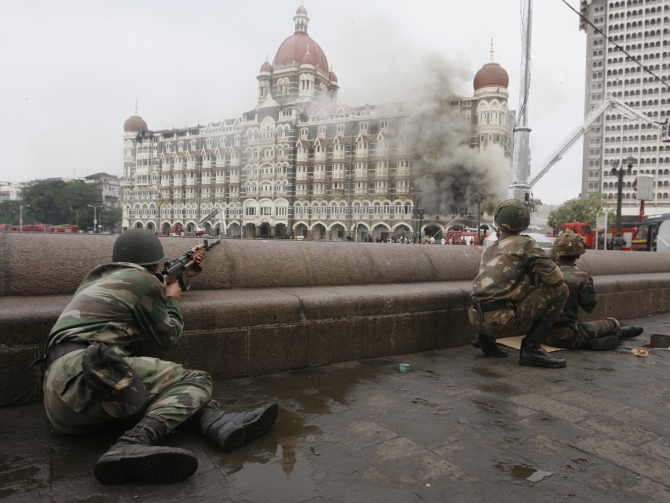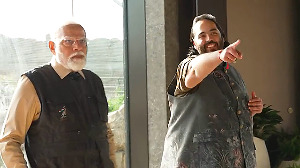 Through its early days to the 1980s, Pakistan sought to expand its sphere of Islamic influence through Afghanistan to Central Asia and got Pakistani citizens recruited in the Afghan government institutions in the 1990s when the Taliban were power. Now, it is looking eastward through India to Bangladesh and Myanmar to establish an imaginary caliphate.
Through its early days to the 1980s, Pakistan sought to expand its sphere of Islamic influence through Afghanistan to Central Asia and got Pakistani citizens recruited in the Afghan government institutions in the 1990s when the Taliban were power. Now, it is looking eastward through India to Bangladesh and Myanmar to establish an imaginary caliphate.
On the sixth anniversary of 26/11 attacks, India faces primarily two kinds of jihadist terror threats. One, as a society, it is witnessing the birth of self-radicalising Muslim youth who are attracted to the jihadist call of the Islamic State of Iraq and Syria led by Abu Bakr Al-Baghdadi. This radicalisation can be countered by India's vibrant democracy, pluralism and alert parents.
On November 22, National Security Advisor Ajit Doval told a conference in New Delhi that 5-6 youth recently showed ‘inclination’ to join the ISIS but their parents were first to contact the security agencies in preventing them from doing so.
Doval's optimism must be encouraged.
Second, as a state, India faces a very old-and-new jihadist threat from Pakistan. In September, Al Qaeda leader Ayman Al-Zawahiri announced the establishment of Al-Qaeda in the Indian Subcontinent (AQIS)x`.
The nature of 26/11 and 9/11 attacks reveal interesting characteristics. Both appear to have been planned by a single person or organisation. On 9/11, the jihadists launched airborne invasions of US cities.
On 26/11, they launched a seaborne invasion of Mumbai. They used global positioning system technology to guide planes and boats to reach their targets. This pattern was demonstrated for a third time on September 6 when the AQIS attempted to take over Pakistani frigate PNS Zulfiqar in order to use it to attack US and Indian warships on the high seas.
The three attacks -- 9/11, 26/11 and September 6 -- indeed reveal a deep connection between the Al Qaeda and the Pakistani military's Inter-Services Intelligence. On November 22, Home Minister Rajnath Singh, speaking a few hours before Doval, said in Delhi, "Terrorism in India is fully Pakistan-sponsored. Pakistan says non-state actors are involved. But is the ISI non-state actor?"
Although led by Arab terrorists, Al Qaeda is fundamentally a Pakistani organisation; it was formed in Pakistan in 1988; it is from Pakistan that it spread to the Middle East.
The Al Qaeda is practically a branch of the ISI, which views itself as the ideological guardian of the Islamic state of Pakistan -- both Al Qaeda and the ISI share the same ideological objective -- establishment of the Islamic Caliphate, with the only difference being that the ISI wants Pakistan to be the head of such an international caliphate.
Evidence in the public domain demonstrates that the ISI and the Al Qaeda function in close cooperation. The ISI protected Osama bin Laden in Abbottabad and continues to protect Taliban leader Mullah Mohammad Omar, who is also the top-most Al Qaeda leader, given that all Taliban factions and Al Qaeda affiliates have expressed an oath of allegiance to him as Emir-ul-Momineen (Leader of the Ummah).
Protecting bin Laden in Abbottabad was in tune with the ISI's established policy, as also demonstrated in its protection of jihadist groups' headquarters Muzaffarabad, Bahawalpur and Muridke.
While the Pakistan army carries out the facade of military operations in the tribal region, the Haqqani Network militants are found in Rawalpindi, not in Waziristan. In 2011, US military's top officer Admiral Mike Mullen described the Haqqani Network as the ISI's ‘veritable arm’.
In the late-1980s, as the US was winding up its mission Afghanistan and the Soviets were to about leave, the ISI planned its next jihad in Jammu and Kashmir that peaked through the 1990s. During the 2000s, it tried to take its jihad to India's heartland by using the Indian Mujahideen.
In 2014, as the US is winding up its mission in Afghanistan, the ISI appears to be mounting its next jihadist mission. The establishment of AQIS means that Al Qaeda is being used to advance the ISI's post-2014 strategy.
Through its early days to the 1980s, Pakistan sought to expand its sphere of Islamic influence through Afghanistan to Central Asia and got Pakistani citizens recruited in the Afghan government institutions in the 1990s when the Taliban were power. Now, it is looking eastward through India to Bangladesh and Myanmar to establish an imaginary caliphate.
The AQIS is a Pakistani brainchild, not a product of' an Arab mind.
Former ISI chiefs continue to work for the secret agency in informal capacities. Lt Gen. Zahirul Islam, who stepped down recently as ISI chief, is reportedly involved in the establishment of Bol television channel.
Lt Gen Shuja Pasha, another former ISI chief, was involved in directing the recent protests led by Imran Khan and Tahirul Qadri. Lt Gen Hamid Gul, on whose watch Al Qaeda was established in Peshawar in 1988, remains involved with the ISI. Many times, journalists who went to meet Gul were told that he had gone to the GHQ, the general headquarters of the Pakistan army.
The use of jihadists in the Kargil War and 26/11 was planned when former Pakistan president General Pervez Musharraf was in command, who would later elevate the first ISI chief to the post of army chief, Gen Ashfaq Kayani.
To Indians, the ISI's involvement in the 26/11 attacks is clear. To the world, the 9/11 attacks are blamed on Al Qaeda, as it is considered undiplomatic to accuse nation-states of such involvement without police-like evidence.
Even if you look before the 9/11 attacks, an ISI connection is evident. It was relatively a short period from 1988 when Al Qaeda was formed to 1993, when the Central Intelligence Agency headquarters at Langley and WorldTradeCenter were first attacked.
Al Qaeda wasn't at peak then, and the 1993 attacks could not have been carried out without some form of state support, especially since footprints led back to Islamabad.
An excessive focus on footmen involved in specific jihadist attacks helps the ISI to escape global attention for its role in 1993 attacks on the WTC and Langley, or in the 9/11 and 26/11 attacks.
As India remembers the Mumbai attacks this Wednesday, the jihadist threats are multiplying.
The following recent developments appear to originate from a concerted strategy from the ISI. First, the AQIS was established to target India. Second, Punjabi Taliban chief Asmatullah Muawiya announced ceasefire against Pakistan, vowing to fight in Afghanistan.
Third, the Pakistani media reported that Muawiya had joined hands with the Haqqani Network, which is part of the Afghan Taliban. Fourth, Pakistan's national security advisor Sartaj Aziz commented that terrorist groups that are not dangerous to Pakistan must not be targetted. Fifth, Prime Minister Nawaz Sharif joined this ISI strategy when he announced that Pakistan will talk first with Kashmiri secessionists before any dialogue with India.
The year 2014 is effectively 1988 when the Al Qaeda was formed and the ISI's control of Pakistan's foreign policy was total
Image: Army soldiers take position during a gun battle at the Taj Mahal hotel (seen in the background) in Mumbai in thisphotograph taken on November 29, 2008. Photograph: Desmond Boylan/Reuters
The views expressed in the above article are that of Tufail Ahmad, an independent columnist, a former BBC Urdu Service journalist, and director of the South Asia Studies Project at the Middle East Media Research Institute in Washington D C











 © 2025
© 2025